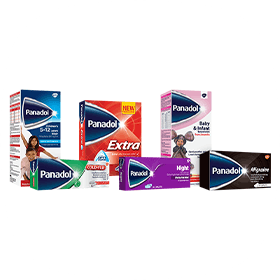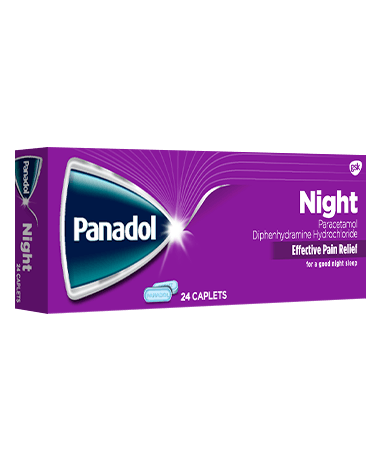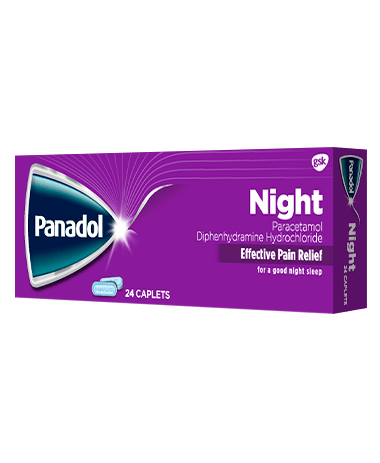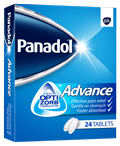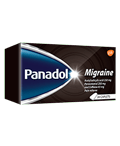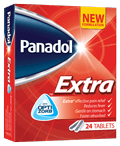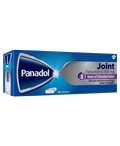Panadol Night

500mg Paracetamol + 25mg Diphenhydramine hydrochloride
Panadol Night contains two active ingredients, Paracetamol which is an analgesic (a pain reliever which relieves aches) and antipyretic (reduces body temperature when you have a fever) and Diphenhydramine hydrochloride, an antihistamine with additional sedative properties.
What does it relieve?
Panadol Night are film coated caplets that contain: Paracetamol: is analgesic and antipyretic. Diphenhydramine Hydrochloride: is a sedating antihistamine with antimuscarinic and sedative properties.
Panadol Night is used for temporary relief of pain when associated with sleeping difficulty, for example:
- Rheumatic and muscular pain
- Arthritis
- Backache
- Toothache
- Migraine, headache
- Period pain
- Neuralgia
Relief of fever.
What's the format?
Film coated caplets.
What are its features?
Panadol Night relieves night time pain so you can have a good night sleep.
- Read more
- Read less
Dosage
For oral administration only.
- To be taken at bedtime.
- For Adults: Do not take for more than 3 days without consulting a doctor. If symptoms persist, medical advice must be sought.
This product contains paracetamol. If you are taking any other medicine containing paracetamol you must make sure you do not take more than 4000mg paracetamol (including this product) in any 24 hours period. If in doubt, consult your doctor or pharmacist. Allow at least four hours between taking any paracetamol-containing product and this product.
For children: paracetamol should not be taken for more than 48 hours except on medical advice.
Adults and children aged 12 years and over: The lowest dose necessary to achieve efficacy should be used for the shortest duration of treatment.
- 1-2 caplets to be taken 20 minutes before bedtime.
- Do not take more than two caplets in 24 hours
- Do not take if you have taken any other medicine containing paracetamol in the last 4 hours.
Children:
- Do not use in children under 12 years of age.
Elderly:
- Should not be taken by elderly patients with confusion. - Sedating antihistamines may cause confusion and paradoxical excitation in elderly.
Also available in:
Usage directions, ingredients and warnings
Before using Panadol Night be sure to check the product ingredients and directions for use, and make sure you are familiar with any warnings and precautions.
Learn more below.
Place caplet(s) in mouth and swallow with water.

Active ingredients:
- Paracetamol 500mg
- Diphenhydramine hydrochloride 25mg
Disclaimer
Before you take Panadol Night
- This product contains paracetamol. Do not use with any other paracetamol-containing products.
- The concomitant use with other products containing paracetamol may lead to an overdose.
- Paracetamol overdose may cause liver failure which can lead to liver transplant or death.
a. Do not take Panadol Night in case of:
Known or previous history of hypersensitivity to paracetamol, Diphenhydramine or any other ingredient in the product. Diphenhydramine is contraindicated for use in patients with:
Narrow-angle glaucoma, Stenosing peptic ulcer, Symptomatic prostatic hypertrophy, Bladder neck obstruction, Pyloroduodenal obstruction
Diphenhydramine is contraindicated for use in:
Newborns or premature infants, Lactating women, Patients taking monoamine oxidase inhibitors (MAOls),12 years childrens and younger
WARNING: May cause drowsiness. If affected, do not drive or operate machinery.
b. Take special care with Panadol Night :
Please seek medical advice before use if:
- You have been diagnosed with liver or kidney impairment (Because Paracetamol is metabolised in the liver and excreted by the kidney in urine). Underlying liver disease increases the risk of paracetamol related liver damage.
- Cases of hepatic dysfunction/failure have been reported in patients with depleted glutathione levels, such as those who are severely malnourished, anorexic, have a low body mass index or are chronic heavy users of alcohol.
- You have epilepsy (fits) or seizure disorders, myasthenia gravis (a muscle dysfunction), narrow-angle glaucoma (excessive pressure inside your eyes), prostatic hypertrophy (prostate gland enlargement), urinary retention, asthma, bronchitis and chronic obstructive pulmonary disease (COPD).
- You are taking drugs which cause sedation such as tranquillizers, hypnotics and anxiolytics may cause an increase in sedative effects.
- You are using monoamine oxidase inhibitors (MAOIs) or within 2 weeks of stopping MAOI medications.
- You are taking other medicines prescribed by your physician, particularly antidepressants (e.g. venlafaxine or drugs called tricyclic antidepressants), metoprolol or atropine.
- You are taking medicines which make you drowsy or give you a dry mouth (sometimes called anti-cholinergics).
Taking such medicines while you are taking this product may increase the chances of side effects.
- You are elderly who are more likely to experience adverse effects.
Check with your doctor if:
- You have glutathione depleted states such as sepsis or you have a severe infection as the use of Paracetamol may increase the risk of metabolic acidosis.
Signs of metabolic acidosis include:
- Deep, rapid, difficult breathing
- Feeling sick (nausea), being sick (vomiting)
- Loss of appetite
- Contact a doctor immediately if you get a combination of these symptoms.
- Avoid use in elderly patients with confusion.
- Diphenhydramine hydrochloride may cause drowsiness and may increase the effects of alcohol.
- Drowsiness may continue the following day. Those affected should not drive or operate machinery.
- Alcohol should be avoided.
- Do not take for more than 3 days without consulting a doctor. If symptoms persist, medical advice must be sought.
- Children may experience paradoxical excitation with diphenhydramine.
- Panadol Night should not be used with other antihistamine-containing preparations, including topical antihistamines for skin and medicines for cough and cold.
- If your symptoms do not improve, get worsen or new symptoms appeared, you must consult your doctor as these could be signs of serious condition.
- Keep this and all medication out of sight and reach of children.
- Do not exceed the stated dose.
Do not take if you have Hypersensitivity to paracetamol, diphenhydramine, or any other ingredient in this product
Should not be used with other antihistamine-containing preparations, including those used on the skin
c. Taking other medicines:
Paracetamol
- The liver toxic effects of Paracetamol may be increased by the use of alcohol. So do not drink alcohol with this product The anticoagulant effect of warfarin and other coumarins may be enhanced by prolonged regular daily use of paracetamol with increased risk of bleeding; Anticoagulant dosage may require reduction if paracetamol and anticoagulants are taken for a prolonged period of time. Occasional doses have no significant effect.
- Paracetamol absorption is increased by substances that increase gastric emptying, e.g : metoclopramide.
Paracetamol absorption is decreased by substances that decrease gastric emptying, eg propantheline, antidepressants with anticholinergic properties and narcotic analgesics. - Paracetamol may increase chloramphenicol concentrations.
- The risk of paracetamol toxicity may be increased in patients receiving other potentially hepatotoxic drugs or drugs that induce liver microsomal enzymes such as alcohol and anticonvulsant agents.
- Paracetamol excretion may be affected and plasma concentrations altered when given with probenecid.
- Colestyramine reduces the absorption of paracetamol if given within 1 hour of paracetamol.
Diphenhydramine
- Diphenhydramine may potentiate the sedative effects of alcohol and other CNS depressants (e.g. codeine, tranquillizers, hypnotics and anxiolytics).
- Monoamine oxidase inhibitors and tricyclic antidepressants (TCAs) may prolong and intensify the anticholinergic and CNS depressive effects of diphenhydramine.
- As diphenhydramine has some anticholinergic activity, the effects of some anticholinergic drugs (e.g. atropine, tricyclic antidepressants) may be potentiated. This may result in tachycardia, dry mouth, blurred vision, gastrointestinal disturbances, urinary retention and headaches
- Diphenhydramine is an inhibitor of the cytochrome p450 isoenzyme CYP2D6. Therefore, there may be a potential for interaction with drugs which are primarily metabolised by CYP2D6, such as metoprolol and venlafaxine.
d. Pregnancy and lactation:
This product should not be used during pregnancy or breast feeding without medical advice. Use of sedating antihistamines during the third trimester may result in reactions in the newborn or premature neonates.
Diphenhydramine has been detected in breast milk, but the effects of this on breast-fed infants are unknown.
e. Driving and using machines:
This product may cause drowsiness, dizziness, blurred vision, cognitive and psychomotor impairment, which can seriously affect your ability to drive or operate machinery. If affected, do not drive or operate machinery.
Medical advice should be sought before use in:
Patients who have been diagnosed with liver or kidney impairment
Patients with epilepsy or seizure disorders, myasthenia gravis, narrow-angle glaucoma, prostatic hypertrophy, urinary retention, asthma, bronchitis and chronic obstructive pulmonary disease (COPD).
Possible Adverse events
When using this product you may experience Sedation, drowsiness, tiredness, dizziness, difficulty concentrating, unsteadiness and dry mouth, which are common. If you are in doubt of any symptoms or signs please consult your physician.
Paracetamol
Stop using this product and consult your doctor immediately if:
- You experience allergic reactions such as skin rash or itching, sometimes with breathing problems or swelling of the lips, tongue, throat or face.
- You experience angioedema or Stevens Johnson Syndrome.
- You experience a skin rash or peeling or mouth ulcers.
- You have previously experienced breathing problems or bronchospasm with acetylsalicylic acid or non-steroidal anti-inflammatory, and experience a similar reaction with this product.
- You experience unexplained bruising or bleeding.
- You experienced liver dysfunction related symptoms or signs. These reactions are rare.
Diphenhydramine
Adverse reactions which have been observed which are considered to be variable between common and rare as fatigue, hypersensitivity reactions including rash, urticaria, dyspnoea and angioedema, confusion, paradoxical excitation (e.g. increased energy, restlessness, nervousness); the elderly are more prone to confusion and paradoxical excitation, sedation, drowsiness, disturbance in attention, unsteadiness, dizziness, convulsions, headache, paraesthesia, dyskinesias, blurred vision, tachycardia, palpitations, thickening of bronchial secretions, dry mouth, gastrointestinal disturbance including nausea, vomiting, muscle twitching, urinary difficulty and urinary retention.
In patients with glutathione depleted states such as sepsis, the use of paracetamol may increase the risk of metabolic acidosis.
May increase the effects of alcohol; therefore, alcohol should be avoided
Concurrent use of drugs which cause sedation such as tranquillizers, hypnotics and anxiolytics may cause an increase in sedative effects therefore medical advice should be sought before taking diphenhydramine with such medicines
Avoid use with other antihistamine-containing preparations, including topical antihistamines and cough and cold medicines.
Use with caution with monoamine oxidase inhibitors (MAOIs) or within 2 weeks of stopping an MAOI
Use with caution with other drugs with antimuscarinic properties (e.g. atropine, tricyclic antidepressants
Use with caution in the elderly, who are more likely to experience adverse effects.
Avoid use in elderly patients with confusion.
If symptoms persist, medical advice must be sought.
Keep out of sight and reach of children.
Enquiries
If you would like any further information regarding Panadol products, please call our INFOLINE (Freecall) +973 16500404 - Gulf & Near East countries

